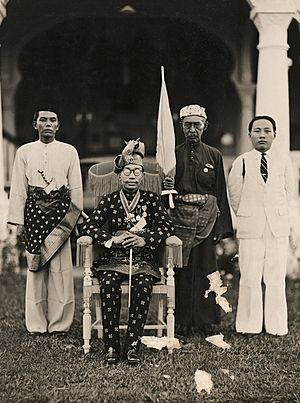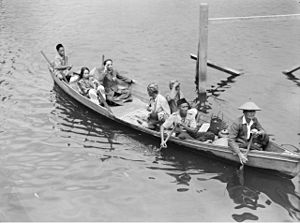Ahmad Tajuddin facts for kids
Quick facts for kids Ahmad Tajuddin Akhazul Khairi Waddienأحمد تاج الدين اعكاظ الخير والدين |
|
|---|---|

Sultan Ahmad (sitting)
|
|
| 27th Sultan of Brunei | |
| Reign | 11 September 1924 – 4 June 1950 |
| Coronation | 17 March 1940 |
| Predecessor | Muhammad Jamalul Alam II |
| Successor | Omar Ali Saifuddien III |
| Born | 22 August 1913 Istana Pekan, Brunei Town, Brunei |
| Died | 4 June 1950 (aged 37) Singapore General Hospital, Singapore |
| Burial | Kubah Makam Di Raja, Brunei Town, Brunei |
| Spouse | 1- Kadayang Amas 2- Tengku Ampuan Hajah Raihani (1934-1950 his death) |
| Issue | 1. YAM Pengiran Anak Datin Seri Setia Hjh Siti Saerah (Belabab Basar) (1928-2013) 2. YAM Pengiran Anak Siti Zubaidah (Belabab Tangah) 3. YAM Pengiran Anak Datin Seri Setia Hjh Siti Halimah (Belabab Damit) (1935-2009) 4. YTM Paduka Seri Pengiran Anak Puteri Hjh Noorehsani (born 1935) |
| Father | Muhammad Jamalul Alam II |
| Mother | Raja Isteri Pengiran Anak Fatimah |
| Religion | Islam |
Duli Yang Maha Mulia Sultan Sir Ahmad Tajuddin Akhazul Khairi Waddien (also known as Sultan Ahmad Tajuddin) was the 27th Sultan of Brunei. He ruled from September 11, 1924, until his death on June 4, 1950. He was given special honors like the Knight Commander of the Order of the British Empire (KBE) and Companion of the Order of St Michael and St George (CMG).
His time as Sultan marked a big change for Brunei. Oil was discovered, which helped the country grow much faster. He also worked to improve education and encouraged religious learning.
Contents
Biography
Sultan Ahmad Tajuddin was born on August 22, 1913, in Brunei Town. He was the oldest surviving son of Sultan Muhammad Jamalul Alam II. His younger brother, Omar Ali Saifuddien III, became Sultan after him. Before he became Sultan, people called him Pengiran Muda Besar Ahmad Tajuddin.
Early Education
He studied at the palace when he was young. One of his teachers was Cikgu Salleh Haji Masri. Salleh Haji Masri was known for fighting against colonial rule. The Sultan and Salleh had a close relationship. Other sons of important leaders also studied with him at the palace.
In those days, it was a tradition for royal children to learn at the palace. This helped them get ready for modern education. However, Sultan Ahmad Tajuddin did not go to regular schools. This was because of strong royal customs at the time. These customs did not allow him to learn with common people. Even so, modern education had started in Brunei in 1914.
He also received a lot of religious education from a young age. His parents invited Islamic scholars to the palace. These scholars taught the royal family about Islam and how to read the Quran.
Becoming Sultan
Sultan Ahmad Tajuddin became Sultan on September 11, 1924. This happened after his father, Sultan Muhammad Jamalul Alam II, passed away. He was only 11 years old at the time. Because he was so young, a group called the Council of Regency ruled for him. This council was made up of Pengiran Bendahara Pengiran Anak Abdul Rahman and Pengiran Pemancha Pengiran Anak Haji Mohammad Yassin. They ruled from 1924 to 1931.
The British Resident in Brunei, Mr. E.E.F. Pretty, attended the ceremony.
Studying in England
In 1932, Sultan Ahmad Tajuddin traveled to England. He had learned English from Mr. H.F. Stalley before his trip. He stayed in England for a year. There, he learned more English and about Western culture. He was the first Sultan to travel so far west. His father had only traveled to Singapore and Labuan.
Marriage
Sultan Ahmad Tajuddin married Tengku Raihani on April 30, 1934. He was 20 years old. Tengku Raihani was the oldest daughter of Sultan Alaeddin Sulaiman Shah of Selangor. She became Tengku Ampuan of Brunei on March 17, 1940. For his wedding, he ordered a new palace to be built. It was named Istana Mahkota Khairani. He and his wife lived there. He also wanted to change the name of Brunei Mosque to Ahmedia Mosque. But after the wedding, the new palace was just called Istana Mahkota, and the mosque kept its original name.
Family
Sultan Ahmad Tajuddin and Tengku Ampuan Raihani had one daughter. Her name was Pengiran Anak Puteri Noor Ehsani, born on October 15, 1935.
Before marrying Tengku Ampuan Raihani, he was married to Kadayang Amas. They had three daughters:
- Pengiran Anak Datin Seri Setia Siti Saerah (born 1928, died 2013).
- Pengiran Anak Datin Seri Setia Siti Zubaidah.
- Pengiran Anak Datin Seri Setia Siti Halimah (born 1935, died 2009).
Since he did not have a son, he adopted two boys:
- Awang (later Haji) Samat bin Mudim Yahya.
- Awangku Bakar (who died during the Japanese occupation).
Coronation Ceremony
Ahmad Tajuddin's coronation as Sultan was held on March 17, 1940. Before this, he gave titles to important leaders who served the country. King George VI gave him a special honor, The Order of Saint Michael and Saint George (CMG). This was suggested by Sir Shenton Thomas, a British official.
After his coronation, the Sultan and his family visited Singapore, Johore, Kuala Lumpur, Selangor, and Penang.
Important Events During His Reign
During Sultan Ahmad Tajuddin's rule, Brunei Darussalam got its own national anthem. It is called "Allah Peliharakan Sultan". This anthem is similar to "God Save the King" in England. In 1947, Awang Haji Besar bin Sagap wrote the music. Pengiran Setia Negara Pengiran Haji Mohammad Yusuf wrote the words.
That same year, he gave his brother, Pengiran Muda Omar Ali Saifuddien, the title "Pengiran Bendahara Seri Maharaja Permaisuara".
The Japanese Occupation in Brunei
In 1941, war with Japan seemed likely. The British encouraged Brunei and its neighbors to form local defense groups. Sultan Ahmad Tajuddin agreed to create the Brunei Volunteer Force and Special Police Force. These groups would help the British stop a Japanese invasion. About 200 Bruneians volunteered at first. But by the time Japan invaded, few remained. No Allied troops were in Brunei. The Sultan was made an Honorary Colonel of the force.
After Brunei surrendered to the Japanese in December 1941, Sultan Ahmad Tajuddin had to give up his power. The Japanese still recognized him as the head of Islam and royal customs. This was as long as he worked with them. The Japanese advised him to retire. They offered him a monthly payment and medals from the Emperor of Japan.
Hiding in Tantaya and Brunei's Freedom
By mid-1945, the Japanese were losing the war. Their soldiers in Brunei became more violent towards the people. A plan was made to keep the Sultan and his family safe. Sultan Ahmad Tajuddin and his family, along with loyal palace staff, were hidden. Kasim bin Tamin, the village headman of Tantaya, helped them.
A small palace was built in Tantaya. The Sultan lived there for about three months. This was until the Australian army took back Brunei. Villagers guarded the palace to protect against Japanese attacks. While in Tantaya, the Sultan lived like a regular person. He enjoyed eating Pulut Mangat, which Kasim often gave him.
After Japan surrendered, the Sultan and his family returned to Brunei Town. This was on a Thursday, around 3:00 am. He was taken to the British Army Headquarters. From there, he went to Istana Parit.
Sickness and Death
Sultan Ahmad Tajuddin fell ill while stopping in Singapore. He was on his way to the United Kingdom. He was taken to the Singapore General Hospital on June 3, 1950. Mr. Malcolm MacDonald, a British official, was with him. Doctors said the Sultan's health was getting worse. His trip to London had to be delayed or canceled. The Sultan had bleeding in his stomach and needed a blood transfusion. He later went into a coma. He died a few hours later on June 4, 1950. His body did not respond to the blood transfusions.
Funeral
When people heard about his death, the Crown Prince of Johore, Tengku Ismail, went to the hospital. He helped bring the Sultan's body to Istana Besar in Johore Bahru. As a sign of respect, Singapore's government lowered flags to half-mast for two days. In Johore Bahru, his body was prepared for burial. Syed Salim bin Syed Hasan, the Chief Qadhi of Johore, washed and wrapped his body. The funeral prayer was led by the Mufti of Johore, Syed Alwi Al-Hadad.
His body was then placed at the Grand Palace of Johore Bahru. This allowed important people to pay their respects. These included Mr. Malcolm MacDonald, Sir Henry Gurney, and Sir Franklin Charles Gimson.
On June 5, 1950, his coffin was flown to Labuan. The British Royal Air Force carried it. His wife and family went with him. Many important people were at Kallang Airport to say goodbye.
In Kelantan, all government offices lowered their flags for three days. This showed their sadness. In Penang, many ships lowered their flags on June 5, 1950. When the plane arrived in Labuan, a police parade honored the Sultan. His coffin was then taken to a jetty to be brought to Brunei by ship.
When the ship arrived in Brunei Town, many people were sad. The Royal Family, leaders, and citizens were there. His coffin was taken to the Palace. It was then placed at the General Office of the Government of Brunei. This gave everyone a last chance to pay their respects.
Before the burial on June 6, 1950, his brother, Pengiran Bendahara Seri Maharaja Permaisuara Pengiran Muda Omar Ali Saifuddien, became the 28th Sultan of Brunei. The coffin was carried from the Palace to the Royal Mausoleum. His brother, the new Sultan, and many others followed. He was buried next to his father, Sultan Muhammad Jamalul Alam II, and his grandfather, Sultan Hashim Jalilul Alam Aqamaddin.
Malcolm MacDonald once said about Sultan Ahmad Tajuddin:
He was one of the most colourful people I have ever met. We had many interesting times together. I will always miss his lively personality on future visits to Brunei. He came from an old royal family. For centuries, this family ruled the State of Brunei, which is very important in Southeast Asian history. Today, we feel for the late Sultan's wife, family, and people who are sad about his passing.
—Letter from Malcolm MacDonald to the British Resident in Brunei, June 5, 1950
Aftermath
After his death, his wife and daughter lived in Kuching. Later, they returned to Selangor. In 1960, Sultan Omar Ali Saifuddien III learned that Tengku Ampuan Raihani would marry someone else. He stated that if she remarried, she could no longer wear royal items. Her monthly allowance would also stop. Tengku Ampuan Raihani passed away in the mid-1990s.
Places Named After Him
Sekolah Rendah Ahmad Tajuddin, a primary school in Kuala Belait, is named after the Sultan.
Books
- Panduan Keselamatan (Safety Guides), written in 1939.
- Reign of Sultan Ahmad Tajuddin - Government, Community, and Change, written in 2011 by Haji Muhaimin bin Haji Mohamed.
Honours
- King George V Silver Jubilee Medal - 1935
- King George VI Coronation Medal - 1937
- Companion of the Order of St Michael and St George (CMG) - 1940
- Knight Commander of the Order of the British Empire (KBE) - 1949
See also
 In Spanish: Ahmad Tajuddin para niños
In Spanish: Ahmad Tajuddin para niños



